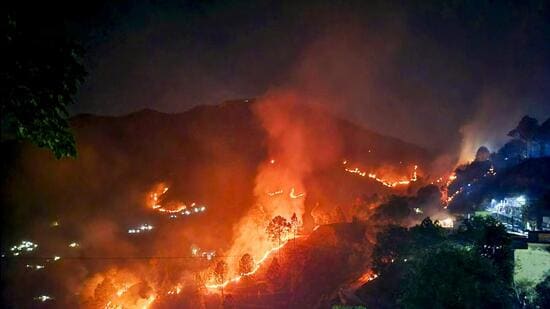Scanty winter rain a key reason for surge in Uttarakhand forest fires
Uttarakhand has recorded 6,701 instances of big and small forest fires this April, compared to only 900 in the same period last year.
Uttarakhand has recorded 6,701 instances of big and small forest fires this April, compared to only 900 in the same period last year, data from the Forest Survey of India has shown.

The hill state has experienced 108 forest fires in the past 72 hours, damaging over 142 hectares of forest land, primarily in the Kumaon region. On Saturday, the Indian Air Force deployed two choppers and the Army assisted forest officials to douse the fire blazing across the tourist hot spot of Nainital.
Data HT analysed from Nasa’s Fire Information for Resource Management System (FIRMS) showed that the number of fires detected between April 1 and 27 is 127% higher than the average number of blazes seen between 2012 and 2021.
Experts attributed this year’s alarming spike to an exceptionally dry winter, followed by below normal spring rain.
While there are forest fires in Himachal Pradesh and western Nepal also, the fires in Uttarakhand, more notably Nainital, are “big and blazing”, observed Shekhar Pathak, historian and academic specialising in Uttarakhand’s people’s movements.

“One of the main reasons for this is the major deficiency in winter rain or snow this year. Himalayas have faced a dry spell September onwards and that has not been compensated,” said Pathak.
Read more: Nainital forest fire: CM holds review meet, forest officers' leaves cancelled | Updates
January ended with an overall rain deficiency of 58%, with 91% rain deficiency over northwest India. The deficiency improved in February which saw a high number of western disturbances bring rainfall to northwest India, which still fell short of replenishing the water sparse region.
HT reported on January 23 that six states and two Union territories in northwest India recorded nearly 100% rain deficiency in the peak winter month. This meant that there was no rain or snow in Delhi, Punjab, Haryana, Jammu and Kashmir; while the hill states of Uttarakhand and Himachal Pradesh recorded a 99% rain deficiency.
Since March 1, Uttarakhand has recorded a 17% rain deficiency.
A senior FSI official said conducive environmental and meteorological conditions help these fires grow.
“One of the main reasons of this massive spike in fires in Uttarakhand is scanty rain, high fire load on the ground, lack of soil moisture and some heat islands in the region. We haven’t conducted an official analysis yet,” said the official, not wishing to be named.
Read more: Army called in as forest fires rage in Uttarakhand; CM Dhami to preside meeting
“Over 90% of forest fires in India are anthropogenic in nature but not intentional. Conducive environmental and meteorological conditions help these fires spread beyond control,” he said.
Incidentally, this is also the season when pine leaves and needles shed, creating an environment conducive for fires to spread, Pathak said.
“Along with the dry spell, this is also the season when pine leaves and needles shed. Together they can create favourable conditions for fire. In the Himalayas, we mostly see ground fires, if the forest floor or ground is cleared, it cannot spread so much,” he said, adding that the clean-up may not have been done properly this year with authorities engaged in the ongoing Lok Sabha election process and local communities that were once deeply involved in forest management, having become increasingly aloof.
“Around 64% of Uttarakhand’s area are forests of which 25% are pine monocultures. Pine used to be commercially important especially during the British period. But they need management,” Pathak explained.
Pathak urged for engaging locals in the dealing with the crisis.
“This problem cannot be addressed without community involvement,” Pathak, who is based in Nainital, added.
HT reported on September 1 last year that forest fires are increasing in intensity and spread, burning nearly twice as much tree cover globally as they did 20 years ago.
The worst affected are the Boreal Forests that cover large coniferous forests in Russia, Canada, US, Finland, Norway, China and Japan, followed by tropical forests covering biodiversity hotspots such as the Amazon, and the rainforests in southeast-Asia and India.
Get World Cup ready with Crickit! From live scores to match stats, catch all the action here. Explore now!
See moreGet Current Updates on India News, Budget 2024, Weather Today along with Latest News and Top Headlines from India and around the world.
Continue reading with HT Premium Subscription




